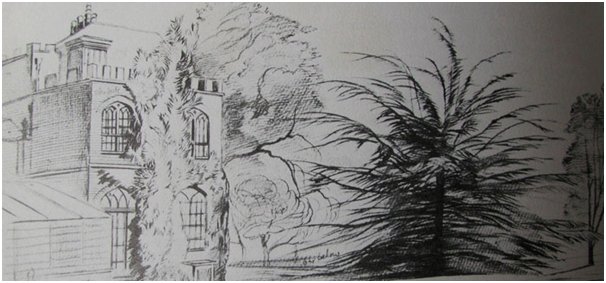Edward Lear met the Tennysons through their mutual friend Franklin Lushington. Tennyson’s sister was married to Lushington’s brother Edmund. Lear and Tennyson admired and responded to one another’s work. Below I’ll briefly discuss Tennyson’s poem written in response to one of Lear’s books.
In 'Edward Lear and His World', John Lehman writes about Lear’s close relationship with Emily Tennyson: ‘Emily became one of his dearest friends’ (27). His feelings for Emily are made clear in a letter he wrote to Chichester Fortescue (later Lord Carlingford) in 1859 after a visit to Farringford:
I should think, computing moderately, that 15 angels, several hundreds of ordinary women, many philosophers, a heap of truly wise and kind mothers, 3 or 4 minor prophets, and a lot of doctors and schoolmistresses, might be all boiled down, and yet their combined essence fall short of what Emily Tennyson really is. (Lehman 27)
A Frequent Guest
Lear was a frequent guest at Farringford and an even more frequent correspondent with the Tennyson family, especially Emily. In letter after letter he expresses the joy he felt when he last visited and the regret that he cannot be with them always. On 9 October 1856, apparently after not having written to Emily for some time, he writes from Quarantine Island, Corfù to apologise; ‘I do write—but I destroy what I write . . . Forgetting you or Alfred or Faringford [sic] is always a fiddlededeeism & impossible’.
A letter he wrote to Emily a year before this one makes clear why it would be impossible for him to forget the Tennysons and Farringford: ‘I have thought of Faringford at all times & seasons ever since I left’. He goes on to write almost a page about how much he misses being with them and how he imagines he sees and hears them throughout each day.
A Bright Blue and Green Landscape
He describes his time at Farringford as ‘a bright blue & green landscape with purple hills, & winding rivers, & unexplored forests, and airy downs, & trees & birds, & all sorts of calm repose’. This list of images is calm in the sort of images created and excited in the speed with which they accumulate with each ampersand. He contrasts this image with his life away from Farringford, a life which he has ‘exchanged for a dull dark plain horizonless, pathless, & covered with cloud above, while beneath are brambles & weariness’. This rather colourless description demonstrates that he feels more alive when he is with his friends.
Given his artistic talents, it is not surprising that Lear expresses his feelings about Farringford by describing landscapes. Though he is probably now most famous for his nonsense verse and accompanying illustrations, he was primarily known for his travel writing and landscape painting in the nineteenth century. Click this link to see some of Lear's landscapes.
Landscapes and Travels
According to Agnus Davidson’s biography of Lear, Edward Lear: Landscape Painter and Nonsense Poet (1812-1888), Lear sent Tennyson a copy of his Journal of a Landscape Painter in Greece and Albania (1851) and Tennyson ‘expressed his appreciation of it in a poem’ called ‘To E. L. on his Travels in Greece’, which you can read here and be sure to also look at Lear’s parody of the poem here.
Lear may have been most famous for his foreign landscapes and travel books, but he also painted domestic landscapes. Given his affection for Farringford and its inhabitants, it is unsurprising that he produced a sketch of the house and immediate grounds.

In this sketch, the house is rendered in some detail as are two Tennyson’s most famous trees, both made famous in his poem ‘To Ulysses’. The tree that looks like a billowing cloud at the top right hand corner of the house could very well be the giant ilex Tennyson memorialises in line 17 of ‘To Ulysses’. The ‘cedar green’ from line 16 is easier to identify; it is the dark, spidery tree in the foreground of the drawing.
Unfortunately these trees are no longer standing, but it is nice to get a sense of the atmosphere they helped to create in the grounds from this drawing. Clearly, Lear loved the grounds of Farringford as much as Tennyson did.